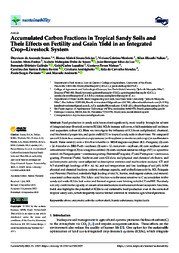Accumulated Carbon Fractions in Tropical Sandy Soils and Their Effects on Fertility and Grain Yield in an Integrated Crop–Livestock System.
Accumulated Carbon Fractions in Tropical Sandy Soils and Their Effects on Fertility and Grain Yield in an Integrated Crop–Livestock System.
Author(s): SOARES, D. de A.; SEKIYA, B. M. S.; MODESTO, V. C.; NAKAO, A. H.; FREITAS, L. A.; SOUZA, I. M. D. de; LUZ, J. H. S. da; GALINDO, F. S.; LUPATINI, G. C.; MATEUS, G. P.; BONINI, C. dos S. B.; ANDRIGHETTO, C.; MENDES, I. de C.; PAVINATO, P. S.; ANDREOTTI, M.
Summary: Food production in sandy soils has evolved significantly, most notably through the advent of integrated crop–livestock systems (ICLSs). ICLSs increase soil cover, which maintains soil moisture and sequesters carbon (C). Here we investigate the influence of ICLSs on soil physical, chemical, and biochemical properties, and grain yield (GY) in tropical sandy soils in short-time. We compared seven ICLSs in two consecutive crops seasons (with soybean or maize as cash crops) in southeastern Brazil. These were (1) corn + Urochloa brizantha cv. BRS Paiaguás—soybean (ICL-Paiaguás); (2) corn + U. brizantha cv. BRS Piatã—soybean; (3) corn + U. ruziziensis—soybean; (4) corn–soybean under conventional tillage (CT) as a negative control; (5) corn–soybean under no-tillage (NT) as a positive control; (6) Paiaguás grass—continuous grazing (Perennial Paiaguás); (7) and Piatã grass—continuous grazing (Perennial Piatã). Soybean and corn GY data, soil physical and chemical attributes, and soil enzymatic activity were subjected to descriptive statistics and multivariate analysis. CT and NT shared high loadings of H + Al, Al, and soil temperature and low loadings of soil pH, SOM physical and chemical fractions, cationic exchange capacity, and arylsulfatase activity. ICL-Paiaguás and Perennial Piatã had a similarly high loading of total N, humin, total organic carbon, and mineral-associated carbon stocks. The fulvic acid fraction was the most sensitive to C accumulation in the sandy soil under ICLSs. Soil water and thermal regimes were limiting in both CT and NT. The study not only confirms the capacity of conservation mechanisms to enhance soil-based ecosystem functions, but it also highlights the potential of ICLSs to aid sustainable food production even in the context of tropical sandy soils, which frequently receive limited attention in intensive agricultural practices.
Publication year: 2023
Types of publication: Journal article
Unit: Embrapa Cerrados
Keywords: Carbono, Cobertura do Solo, Solo Tropical, Substância húmica
Observation
Some of Embrapa's publications are published as ePub files. To read them, use or download one of the following free software options to your computer or mobile device. Android: Google Play Books; IOS: iBooks; Windows and Linux: Calibre.
Access other publications
Access the Agricultural Research Database (BDPA) to consult Embrapa's full library collection and records.
Visit Embrapa Bookstore to purchase books and other publications sold by Embrapa.

